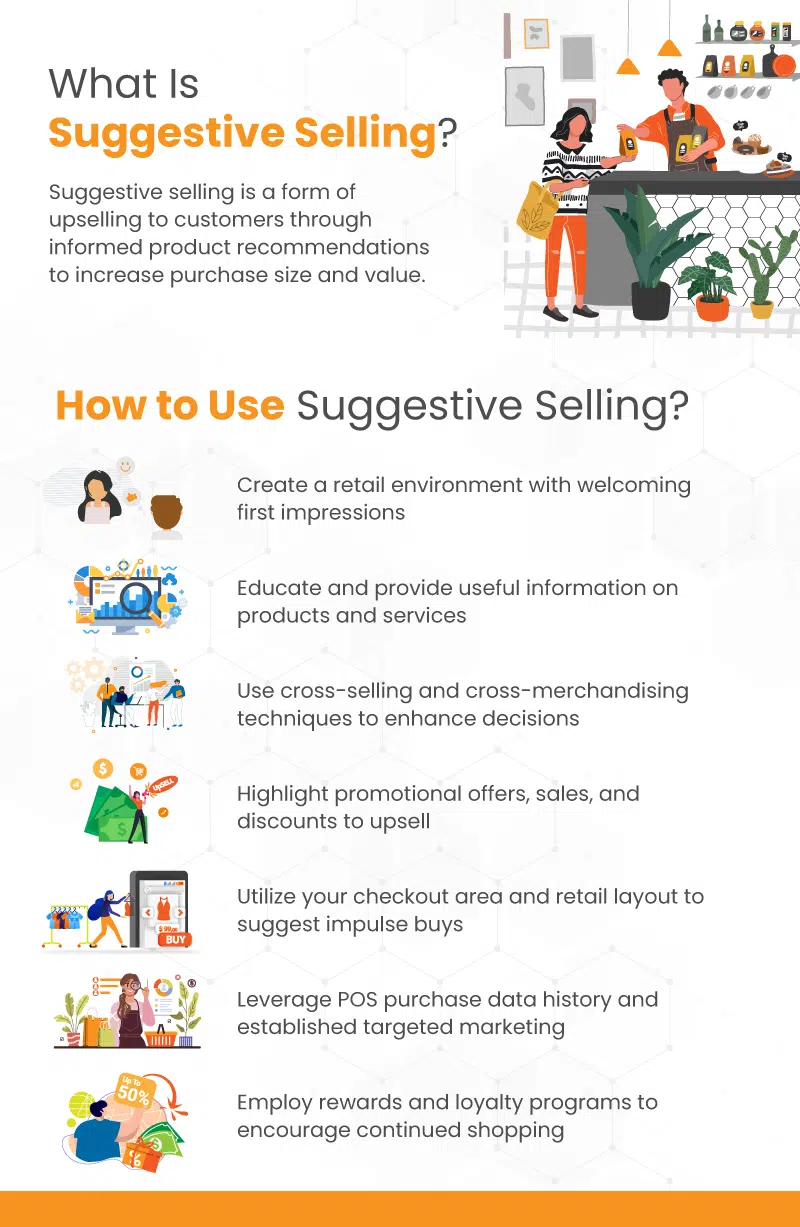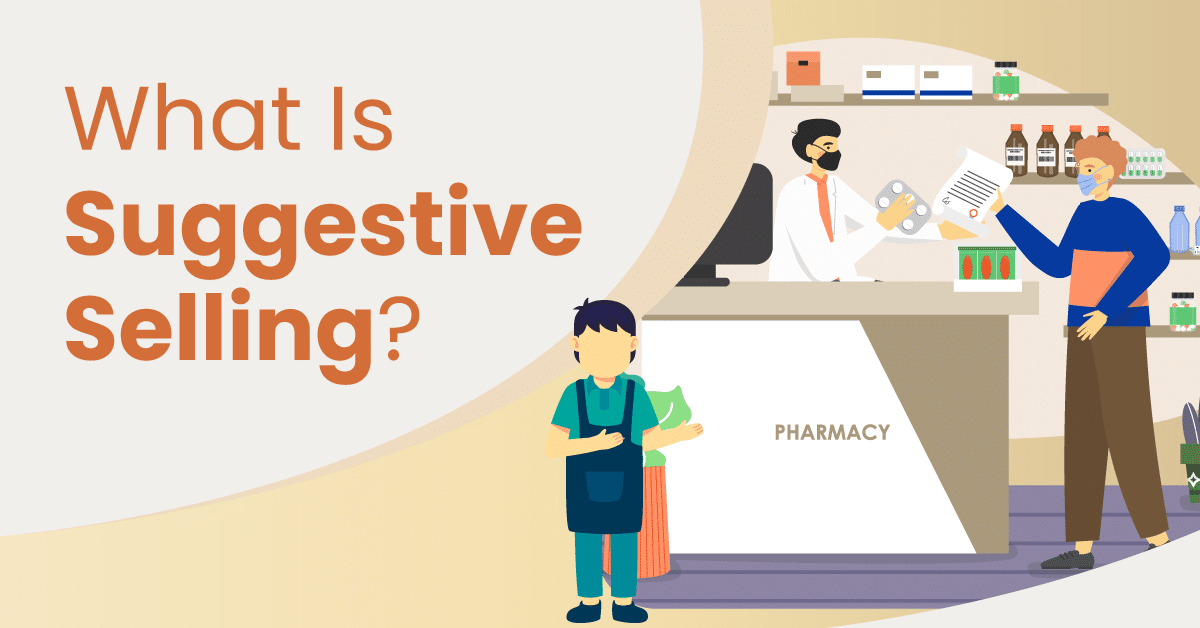
Encouraging your clientele to make purchases in a convincing but thoughtful manner should be at the forefront of your sales team training. Considering how difficult it is to acquire new customers, you must take advantage of all foot traffic in your store. And that’s where suggestive selling comes in. But what is suggestive selling?
Suggestive selling refers to a strategy of upselling by making product recommendations to customers based on their initial buying intent. The ability to upsell and cross sell products to increase your purchase size and volume can do wonders for your overall revenue. However, there’s an art to it. It’s important to read each customer well and avoid being pushy or too salesy. Read on to learn more about how to use suggestive selling in retail.
What Is Suggestive Selling?
Suggestive selling is a form of upselling. Done correctly, sales associates will make gentle, informed suggestions in order to increase purchase size or value. Ideally, such an added or enhanced purchase will also provide more value to the customer, creating a win-win situation for both parties.

First Impressions
Create a retail environment that aims to have an immediate impact on customers when they walk through the door. Get their attention in a welcoming and friendly manner. Try to figure out why they’ve visited the store in the first place, and offer to highlight promotions, seasonal goods, and specialty items.
Give your guests space to decide if they want to continue the conversation. You can always carry it further by asking more questions to get to know more about their tastes and preferences. Fostering a culture of centering your clientele’s purchase intent and their perception of your products can help you cater better suggestive selling strategies when that time comes around.
Provide Useful Information
The ability to provide detailed information about products and services adds considerable value to a shopping experience. Train your sales team to be storytellers about what your brand is all about.
Making empty suggestions purely to close a sale, without connecting those suggestions to actual descriptions or meanings behind products, is a surefire way of getting rejected by a shopper. While customers don’t need to be lectured about why your retail business’s items are the best around, giving them some background and basic information about what sets your inventory apart from your competitors can be extremely useful.
Suggestion Selling With Cross Selling And Cross Merchandising

Cross-selling involves suggesting complementary products that are related to the original item that a shopper intended to purchase. For this technique, wait until the shopper has committed to making the original purchase to make the suggested cross-sell. Try not to overwhelm shoppers with too much information or too many options.
Gathering information about the customer’s tastes and preferences is important, too. For example, if you run a liquor store and are featuring a new gin brand that you’re excited about, you can offer multiple cross-selling options to your sales team. Encourage them to ask the shopper what they plan on doing with the gin. If they’re making martinis, they can showcase the dry vermouths you have in stock and provide them with some background on how they differ in flavor. If they want to make dirty martinis, your staff can point out where you keep the jars of Spanish olives.
There you go. Your employee just used cross-selling to increase the purchase size and value, all while enhancing the customer’s experience.
Bundle Items
Similar to cross-selling, bundling items refers to offering a reduced-price deal for buying multiple related items. This strategy offers a more singular purchase flow, where a customer doesn’t have to make a separate decision to initiate buying an additional item. Bundling can help retailers unload slow-moving products, increase purchase sizes, and provide packaged deals that make sense for customers.
For example, if you own a sneaker store and stock tennis shoes for $95 and tennis socks for $15, you can consider creating a bundle for both the shoes and the socks for $100. Buy one get one off is another popular bundling strategy taken by retail companies.
Highlight Sales or Promotional Offers
Showcase your discounts and promotional offers to customers when they enter your brick-and-mortar store. Calling attention to sale items can actually be a great way to upsell guests. Try to highlight the value of the sale item as a reason to go for the more expensive product.
For instance, let’s say you own a sporting goods store and a shopper wants to buy a $20 plastic water bottle. You might suggest to them that you have a $50 metal water bottle on sale for $40. By explaining to the customer that the metal water bottle will last longer and keep water colder, you can increase their perception of the bottle’s value. If they buy the metal bottle, then you also increase the value of the sale.

Impulse Buys at the Front of Your Store
Use your retail store’s floor design to increase impulse buys. Putting smaller, less expensive items like chocolate bars and magazines is a more obvious example of impulse buys for stores like supermarkets. Having these items near your point of sale system can help increase your store’s revenue, acting as a nonverbal suggestive selling technique.
A bookstore might have greeting cards or stuffed animals at the front register. If someone is buying a gift for a friend or a young family member, they will be enticed to add one of these items to their card before they check out.
Use POS Data
With a smart, robust point of sale like KORONA POS, you can easily make use of previous sales data for specific customers. This information helps retail establishments segment their discounts as promotions for marketing emails. In addition, it provides details about shoppers to sales floor employees in your brick-and-mortar shop.
Get started with KORONA POS today!
Explore all the features that KORONA POS has to offer with an unlimited trial. And there’s no commitment or credit card required.
Harness Customer Purchase History
While chatting with clientele and asking them questions is a great way to learn more about their preferences, consider supplementing that with actionable insight straight from your POS. Leveraging this purchase data history can help you learn what suggestions are best and which are better to avoid.
Additionally, your customers will appreciate the fact that you cared to notice their preferences and character. Use this opportunity to ask them for feedback about products they’ve bought in the past.
Use Segmented and Targeted Marketing Emails
Encourage your customers to come and shop at your store with personalized marketing. Leverage your sales data to know more about each individual shopper profile, and taper your emails with segmented, data-driven marketing campaigns. By knowing which clients purchased what during certain holidays or seasons, you can entice them to come back to your store with tailored promotions and discounts. This can be a very useful digital form of suggestive selling.
Loyalty and Rewards
Train your staff to emphasize your rewards programs. KORONA POS integrates with bLoyal loyalty marketing software. Give your clientele a reason to feel appreciated and encouraged to continue shopping at your store.
While it may seem minute in the psychological process of suggestive selling, competitive rewards programs might be the aspect that sets you apart from other retailers. Even a simple points-based rewards system can make your shoppers feel valued and inspire them to buy more items or return more often.
FAQs: Suggestive Selling
Suggestive selling is a sales technique. It is very similar to upselling, but with added and updated insights and strategies, including more gentle and personalized tactics.. Salespeople will use suggestive selling to add additional products on to a purchase, or suggest higher prices products based off of perceived value.
The easiest way to suggestively sell is to listen to your customers and give them something that is actually of value to them. By communicating with your clientele and determining their tastes and preferences, as well as leveraging their purchase history, you can cater your suggestions to be more effective and useful for both parties.
Yes, suggestive selling absolutely works. There are plenty of big brands and retail companies that have implemented cross selling, bundling, and segmented product marketing to increase their cart sizes, purchase values, and profits.
Suggestive selling increases profits by encouraging purchases with higher value and size. In addition, bundling can help retail companies clear stagnant stock off of their shelf, freeing up capital to purchase new inventory.













